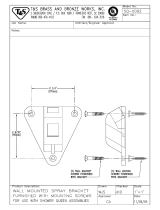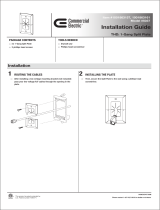Page is loading ...

Limit Adjustments
Please Note: Screen limits are factory set for optimum performance of the
screen. A procedure is outlined below for minor tweaks, but any adjustment
of these limits may negatively affect the flatness of the screen surface and
could also void the warranty. Please check with Draper prior to resetting
screen limits.
CAUTION: Always be prepared to shut screen off manually when new
adjustment is being tested. Screen may be severely damaged if viewing
surface is allowed to run too far up or too far down.
CAUTION: Be sure all switches are in “off” position before adjusting limit
switches.
The motor limit screws are normally located on the audience left of screen roller.
"Down" Limit Adjustment
To Reduce Screen Drop
1 Raise screen surface about 1' above desired setting and turn off.
2 Turn the WHITE/DOWN limit screw clockwise (3 screw turns=½ roller revolution).
3 Test by running screen down and repeat steps 1 and 2 until desired position is
reached.
To Increase Screen Drop
1 Run screen to the down limit.
2 With the down switch on, turn the WHITE/DOWN limit screw counterclockwise
(three turns of screw = ½ roller revolution) to increase drop.
3 Test by running screen up about 1' and back down to new down limit.
4 Repeat steps 2 and 3 until desired position is reached.
"Up" Limit Adjustment
Screen is Running Too Far Up
1 Lower screen surface about 1' below desired setting and turn off.
2 Turn the YELLOW/UP limit screw clockwise (3 screw turns = ½ roller revolution).
3 Test by running screen up.
4 Repeat steps 1 through 3 until desired position is reached.
Screen Needs to Run Up More
1 Run screen down about 1' and turn off.
2 With the up switch on, turn the YELLOW/UP limit screw counterclockwise (three
turns of screw = ½ roller revolution).
3 Repeat steps 1 and 2 until desired position is reached.
CAUTION: Do NOT allow the dowel to wrap up over the roller when the
screen is running up! This could damage the screen.
Installation/Operating Instructions
Signature/Series E & V Electric Projection Screen by Draper
Operation
Please Note: Screen limits are factory set for optimum performance of the screen.
Any adjustment of these limits could void the warranty. Please check with Draper
prior to resetting screen limits.
CAUTION—Important Instructions—Signature/Series V—The shipping support
bracket must be removed from the dowel during initial operation before screen is
operated in UP direction. After screen is installed, run viewing surface DOWN to access
and remove bracket. Signature/Series E—The protective paper wrapping around the
viewing surface must be removed before the screen is operated in down direction. Cycle
viewing surface down and up several times to confirm satisfactory operation. If viewing
surface or trap door do not operate properly, turn power off and free trap door and/or
check electrical connections.
When screen is first operated, be cautious! If automatic trap door does not open
immediately up into screen case when switch is flipped “down”, return switch to “off” and
free trap door and/or recheck electrical connections before proceeding. Cycle unit down
and up several times to confirm satisfactory operation.
110-120V Single Station Control—3-position UP-OFF-DOWN switch permits
operation to be stopped at any point. Factory adjusted limit switches automatically stop
screen when fully down or fully up.
110-120V Multiple Station Control—Switches are similar in appearance to 110-120V
Single Station Control. Screen stops when switch is released and may be restarted in
either direction. Factory adjusted limit switches stop screen automatically when fully
down or fully up.
24V Control—Three-button UP-STOP-DOWN switches stop at any point desired,
operate in any sequence. Factory adjusted limit switches automatically stop screen
when fully down or fully up. Wireless controls—whether infrared or radio frequency—
interface with the low voltage control box (see wiring diagram on reverse).
Key Operated Switching—Two kinds of key-operated switches are optionally available
with this unit. 1 The key-operated power supply switch controls power to the screen
and switches. When it is “off”, the switches will not operate screen. Key may be removed
from the switch in either “on” or “off” position. 2 A three-position key switch permits the
screen to be operated directly by key. In this case, the screen’s operator must always
have a key.
RS232/Ethernet—Serial communication and network communication optionally
available with wall switches, RF or IR remote.
Hanging Screen
When locating viewing surface and checking clearance for screen’s operation,
remember surface is centered in case. Screen is normally recessed above ceiling
and may be installed in a variety of ways. See typical installations detailed on back
of this sheet. Regardless of mounting method used, the following points apply:
1 Screen should be lifted into position only by the end mounting brackets.
Keep case level by lifting end plates simultaneously to prevent surface
damage. Never attempt to lift screen along its length.
2 Screen should be positively and securely supported so that vibration or even
abusive pulling on viewing surface will not weaken installation.
3 Installer must insure that fasteners used are of adequate strength and suitable
for the mounting surface chosen.
4 Entire bottom of case must be readily accessible after installation is complete.
5 Hinge that connects bottom panel and automatic trap door of screen must be
permitted to operate freely. Front and back of case must be straight—not forced
to warp or bow. Hinges must be free from mastic or paint buildup, and doors
must be unobstructed by ceiling tiles.
6 Do not use screen case to support adjacent sections of ceiling.
7 If trim pieces must be attached to case, do not permit screws to protrude more
than
1
/
4
" through
1
/
8
" wall of case. Do not attach trim pieces with nails.
8 If case is painted, slots on bottom of case should be shielded to protect viewing
surface from paint splatters or overspray.
9 Do not seal unit in ceiling until electrical connections have been made and
screen has been operated successfully.
Copyright © 2013 Draper Inc. Form SignatureE&V_Inst13 Printed in U.S.A.
Caution
1 Read instructions through completely before proceeding. Follow instructions
carefully. Installation contrary to instructions invalidates warranty.
2 Pick up screen case from ends only. Picking case up at other points will damage
case and may damage fabric.
3 To insure a safe installation, the entire weight of the unit MUST BE supported by
the end-plates.
4 Entire bottom of screen case should be unobstructed to permit proper operation of
automatic trap door, and access to bottom panel for making electrical connections
or servicing.
5 Screen should be installed level (using a carpenter’s level).
6 Nothing should be fastened to screen dowel or viewing surface.
7 Operating switch(es) is packed separately in screen carton. Do not discard with
packing material.
8 Screen operates on 110-120V, 60 Hz., 1.1 amp current draw for models using
small case; 1.3 for models using large case (see page 2).
NOTE: Screen has been thoroughly inspected and tested at factory and found to be
operating properly prior to shipment.
These instructions are meant as a guide only. They do not imply any responsibility on
the part of Draper, Inc. for improper installation or faulty workmanship at the jobsite.
Please Note: Instructions for adjusting Draper’s Tab-Tension System for Series V
screens are on page 2.
®
If you encounter any difficulties installing or servicing your Signature, call your dealer or
Draper, Inc., Spiceland, Ind., (765) 987-7999 or fax (765) 987-7142.
Suitable for use in environmental air space in accordance with Section
300-22(c) of the National Electrical Code, and Sections 2-128, 12-010(3)
and 12-100 of the Canadian Electrical Code, Part 1, CSA C22.1.
Brackets installed with rivets at factory.
Bracket spacing:
•SmallCaseConstruction/Eor/V
-Case length <95"-no brackets required
-Case length >95"-1 bracket centered
•LargeCaseConstruction/Eor/V
-2 brackets equally spaced
3
/8" (9.5mm) -16 threaded rod
(use for suspending
screen) by others.
Case support
brackets. NOT
for use in
supporting
weight of case.
5
/16" (8mm)-18 threaded rod
(use for adjusting
deflection) by others.
3
/8" (9.5mm)-16 threaded rod
(use for suspending
screen) by others.
Electrical Connections
Screen operates on 110-120v, 60 Hz., 1.1 amp current draw for models using
small case; 1.3 for models using large case (see page 2). Junction box is located
just above the access plate at left end of screen. (See chart on back of this sheet.)
Access plate is held closed with flathead screws and may be opened with a
Phillips screwdriver. Automatic trap door does not need to be opened to make field
connections. Removal of access plate exposes red, black and white pigtail leads
and green internal ground wire per wiring diagram attached. Screen is shipped with
internal wiring complete and control switch(es) fully boxed. Wire connecting screen
to switch(es) and switch(es) to power supply should be furnished by installer.
Connections should be made in accordance with attached wiring diagram, and
wiring should comply with National and local electrical codes.
All Operating Switches Should Be “Off” Before Power Is Connected.
Shipping Support Bracket
Dowel (Series V)
US Patent No.
5,341,241

Case Dimensions & Methods of Installation
SCREEN SIZE CASE SIZE
Total Drop <156" or viewing width <144" Small
Total drop >156" or viewing width >144" Large
Wiring Diagrams
Signature/Series E & V by Draper
Page 2 of 2
NOTE: Viewing surface shown is Series V with tab tensioning.
Series E, without tab tensioning, is also available.
Tab-Tension Adjustment
Procedure for Signature/Series V
1 Determine which side requires adjustment.
2 Secure dowel with one hand.
Caution: Do not touch or bend surface.
3 Using Phillips-head screwdriver, depress
spring-loaded adjustment screw
(see drawing) and slowly turn
clockwise to tighten tension, or
counterclockwise to loosen tension.
The screw adjusts in ¼ turn increments.
Adjust only one increment (¼ turn).
4 If problem is not corrected, leave screen in
position for 24 hours to allow surface
material to stretch into position.
5 If problem still is not corrected, repeat steps 2 and 3.
Dowel
Adjustment
Screw
Te nsioning
Cable
Single Station Control
Internal Screen Wiring
White (Common)
Black (Down)
Red (Up)
Green/Yellow (Ground)
Dashed wiring
by electrician
Control
switch
Single gang box by others
Min. 4" x 2
1
/
8
" x 1
7
/
8
" deep
Blue
Black
Red
Location of key
operated on-off
switch if furnished
To 110-120V Line
Multiple Station Control
Internal Screen Wiring
White (Common)
Black (Down)
Red (Up)
Green/Yellow (Ground)
Dashed wiring
by electrician
Red
Red
Black
Blue
Blue
Cap off with wire
nut and tape
Black
Red
Blue
Black
Single gang box by others
Min. 4" x 2
1
/
8
" x 1
7
/
8
" deep.
3 shown. More or less equally
feasible.
Location of key
operated on-off
switch if furnished
To 110-120V Line
www
.draperinc.com
(765) 987-799
9
Two-Way Serial Communication (RS232) with MC1
See separate Serial Communication-RS232 Instruc-
tion sheet for enabling RS232 with the MC1.
3 Button Wall Switch
DOWN - Black
COM - White
UP - Red
White-Common to screen & 110-120V AC Neutral
Red-to screen (directional)
Brown-to screen (directional)
Ye llow-to 110-120V AC-Hot
Black-to 110-120V AC-Hot
Green-Ground
Eye Port for IR Eye, RF Receiver or LED
Wall Switch. For more than one of
these, a splitter is required.
Aux Port for connecting additional LVC-III
modules (up to six total can be linked-
connect from Aux to Eye).
Dashed wiring by electrician
Low voltage wiring by others
White (Common)
Red (Up)
Black (Down)
Green (Ground)
Location of key
operated on-off
switch if furnished
To
110-120V
Line
Internal Screen Wiring
STOP
Control
Switches
24v DC
STOP
Low Voltage & Wireless Control
RS232 Data FROM Control System
RS232 Data TO Control System
Signal Ground & Manual Switch Common
Manual Switch Down
Manual Switch Up
White-Common to screen & 110-120V AC Neutral
Red-to Screen (directional)
Brown-to Screen (directional)
Black-Hot to 110-120V AC
Green/Yellow-Ground
Fuse
Program LED
Eye Port for IR Eye. For RF Receiver or LED
Wall Switch, a Splitter and a Power Supply
is required. Plug RF Receiver or LED Wall
Switch and Power Supply into splitter, then
run cable from Splitter to MC1 Eye Port.
Low Voltage Wiring by others
AC Wiring by electrician
MC1
White (Common)
Red (Up)
Black (Down)
Green/Yellow (Gnd
)
Internal Screen Wiring
Location of key
operated on-off
switch if furnished
To
110-120V
Line
STOP
Control
Switches
24v DC
STOP
Case length
1
1
/
2
" Ty p
Viewing surface
2
1
/8"
A
Series A
E-small case 3
3
/16"
E-large case 4
1
/2"
V Varies
Ceiling grid
and tile
(by others)
9
1
/8"
6"
9¾"
Audience
Electrical connection
to internal splice box
on left end of case.
7
/8"
knockout for
1
/2" conduit.
J-Bo
x cover located under
splice box.
Shown with
3
/8" threaded
rod (provided
by others).
Ceiling grid and tile
(by others)
9
1
/8"
6"
11"
Audience
Electrical connection
to internal splice box
on left end of case.
7
/8"
knockout for
1
/2" conduit.
J-Bo
x cover located under
splice box.
Shown with
3
/
8
" threaded
rod (provided
by others).
Ceiling grid and tile
(by others)
Small Signature Case
Large Signature Case
Caution: Do not remove the roller assembly from the case unless
necessary for repairs. If the roller assembly is removed, be sure mo-
tor is fully re-seated in the bracket, and re-secure it carefully with the
motor retaining spring and screw (see diagram below).
Please note: Maximum
torque for tightening
screw is 5 lb-inches.
Please Note: Do not wire motors in parallel.
Brackets evenly spaced along screen case
/







